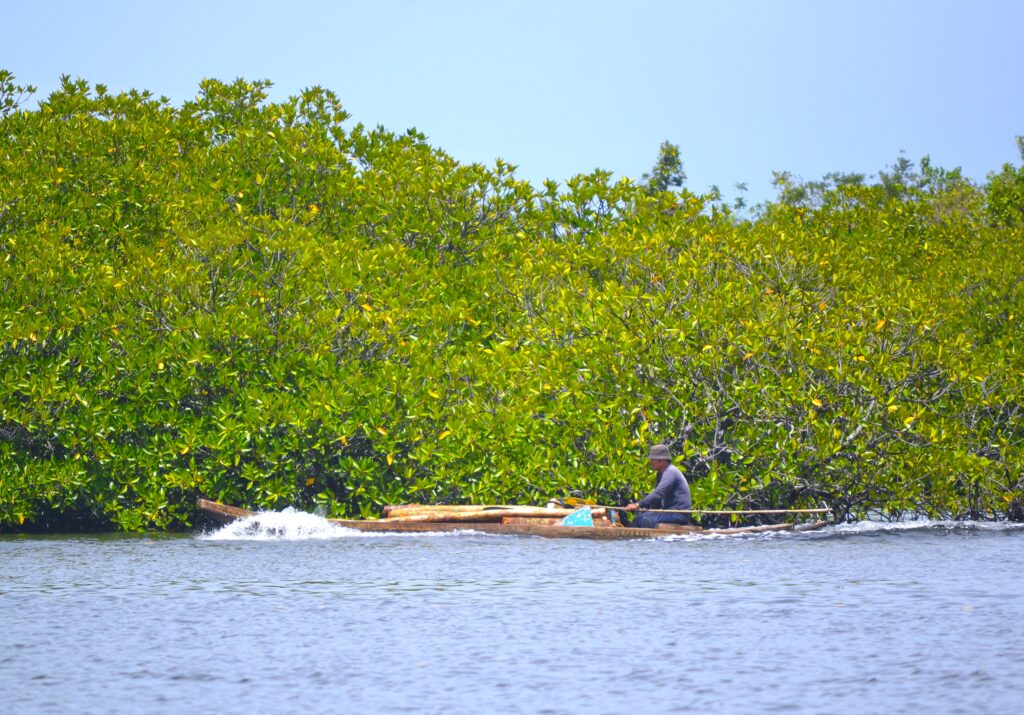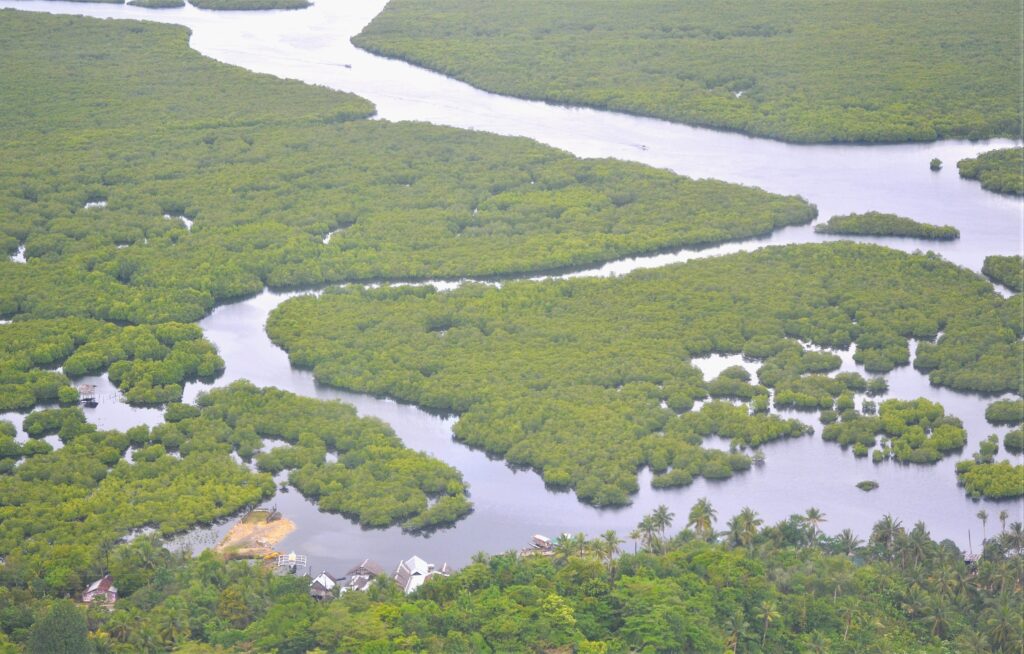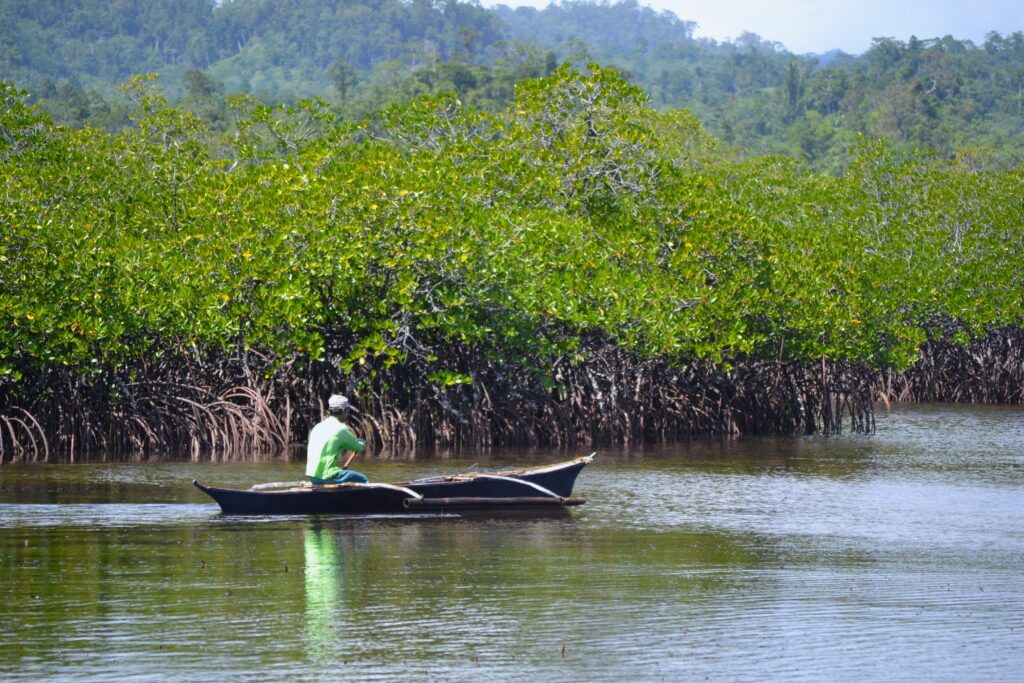Sequestering carbon dioxide by growing more mangroves
Text and Photos by Henrylito D. Tacio
Barangay Dahican in Mati City, Davao Oriental is noted for its 7-kilometer fine white-sand seashore. Most people visit the area to do any of the following: swimming, skimboarding or surfing. Others just want to walk barefoot and enjoy the cool air from the Pacific Ocean.
But what most people don’t know is that barangay Dahican is also known for its diversified mangroves. It is located in sitio Guang-Guang and is known as Guang-Guang Mangrove Forest.
The protected mangrove forest encompasses 21,000 hectares where you can see 18 of the rarest, mostly endangered, mangrove species in the country. People living in Guang-Guang are managing it with support from the Department of Environment and Natural Resources (DENR).
Sitio Guang-guang is located within the Pujada Bay, one of the most beautiful bays in the world. It’s not only the government that is helping the coastal areas to turn green again by planting mangroves.

The Malizia Mangrove Project of the Mama Earth Foundation has been doing that, too. Its effort is done in collaboration with the Davao Oriental State University. So far, it has planted about two million mangroves in the area.
This is good news as mangroves have been identified as one of the key roles in capturing and storing carbon dioxide that would be released into the atmosphere. As such, mangroves help the Philippines to meet its goal of carbon emission reduction.
This is made possible through the blue carbon scheme. The Intergovernmental Panel on Climate Change (IPCC), a Nobel laureate, defines blue carbon as “All biologically-driven carbon fluxes and storage in marine systems that are amenable to management.”
In other words, “Blue carbon is the carbon captured/sequestered, stored and stabilized by plants that grow near the coasts,” explained Russell Christine B. Corcino, a Research Assistant of the Institute of Biology, College of Science at the University of the Philippines-Diliman.
Imagine this: human beings exhale carbon dioxide and this exhaled carbon is being “inhaled” by plants. “Once inhaled, they use the carbon to make food and plant parts (leaves, stems, etc.), thus storing the carbon in their plant parts,” Corcino said. “They can also store it in the soil once they die or when plant parts fall off and get buried in the soil. The soil stores higher carbon than the plant parts.”
Mangrove forests, together with seagrass meadows, have natural capacity to sequester and store enormous amounts of carbon in their ecosystems.
“As carbon sinks, they are a cheap and readily available natural resource useful in mitigating the negative impacts of climate change,” said the late Dr. Miguel D. Fortes, a marine scientist and author of several books and technical articles in refereed journals.

Mangroves and seagrasses can store or capture more than twice – or even four to five times than those forests growing in the uplands. They largely contribute to “our goal of decreasing carbon dioxide in the atmosphere.” In simpler terms, they can be used to adapt or mitigate against the impacts of climate change.
These ecosystem services are touted as “nature-based solutions” since they can perform these sustainable services free of charge for human beings. In fact, blue carbon ecosystems have become integral for climate change adaptation and mitigation programs.
Recent studies conducted by the United Nations Environment Program (UNEP) and International Union for Conservation of Nature (IUCN) found that, when mangrove forests, saltwater marshes and seagrass meadows are preserved, they are “extremely effective” at storing carbon.
In 2009, the concept of blue carbon was introduced to draw attention to the degradation of marine and coastal ecosystems and the need to conserve and restore them to mitigate the impacts of climate change and to recover for the other ecosystem services they provide.
Just recently, five Filipino scientists have come up with a study, entitled, “Status, limitations, and challenges of blue carbon studies in the Philippines: A bibliographic analysis.”
Corcino is the lead author of the study. The other four were Maria Elisa B. Gerona-Daga, Shaina C. Samoza, John Kenneth R. Fraga, and Severino G. Salmo III. The study was funded by the Department of Science and Technology (DOST) through the Philippine Council for Industry, Energy and Emerging Technology Research and Development (PCIEERD) and partly-funded by the United States Agency for International Development (USAID) through the Partnerships for Enhanced Engagement in Research (PEER) program.
Mangrove forests and seagrass meadows have been studied since the 1970s but only recently on its carbon storage capacity. “From our study, we computed that the amount of carbon stored in the country’s existing mangroves and seagrasses alone is around 80,000 times more than our carbon reduction commitments to the United Nations,” Corcino explained in an exclusive interview.
They found out that the carbon storage rate of Philippine mangroves is at 400 Megagram per hectare (Mg/ha), while that of seagrasses is at 80 Mg/ha. “This rate is around half of the average global carbon storage rate,” she said, but added that the estimates were based on very few data points.
In their study, the estimates came from three collected data for seagrass and less than 30 for mangroves. “(This is) not quite representative for an archipelagic country like the Philippines,” Corcino said. “If we can increase our data on blue carbon storage, then probably the carbon stock values can increase and might even exceed that of other Southeast Asian countries.”

Dr. Theresa Mundita Lim, during her time as director of the Biodiversity Management Bureau, says the agency has identified 42 species of mangroves in the country. None of them are facing extinction yet. But the International Union for Conservation of Nature (IUCN) is considering putting 11 out of 70 mangrove species assessed on the IUCN Red List of Threatened Species.
“Mangroves form one of the most important tropical habitats that support many species, and their loss can affect marine and terrestrial biodiversity much more widely,” pointed out Beth Polidoro, who led the first-ever global assessment on the conservation status of mangroves.
“Despite legislation and programs to protect mangroves, the country has lost 75 percent of its mangroves due largely to fishpond development, charcoal production, industrial conversion, reclamation, and pollution,” deplores Dr. Fortes.
Aside from sequestering carbon dioxide, mangroves also play an important role in protecting the communities living in coastal areas.
In November 2013, the Philippines was hit by super typhoon Yolanda (international name: Haiyan), which killed around 6,300 people. The Visayas were severely damaged by the typhoon, particularly the islands of Samar and Leyte. According to reports, the typhoon affected almost 11 million people, many of whom were left without a place to live.
However, because of the robust mangroves that jutted out along their shoreline and functioned as protective barriers, some affected regions were spared from the extensive damage that happened to other areas.
This was discovered by Dr. Moises Neil V. Seriño, a professor in the economics department and the current vice president for planning at Visayas State University in Leyte, following a study he and co-researchers did on the aftermath of Yolanda.
“Our study shows that mangrove vegetation reduced the number of deaths and damaged houses during the Yolanda incident,” Dr. Seriño said. “This property and lifesaving effects of mangrove is robust. Mangroves can protect us (our lives, livelihood and properties) from damaging effects of typhoons.”
Dr. Seriño and his team collected data from the areas where typhoon Yolanda passed through, particularly in Samar, Leyte, Bohol, Cebu, Negros, Panay, and Palawan. “We focused on mangroves because mangroves have suffered degradation in the past decades and these mangrove ecosystems have been doing a very important job of protecting coastal communities from damaging effects of typhoons,” he explained.
“Coastal communities with substantial mangrove cover suffered fewer or less casualty and less housing damages as compared to coastal communities with reduced mangrove cover,” he added.
The Philippines is hit by an average of 20 typhoons a year. “With the threats of climate change in the Philippines particularly storm surges, tsunamis and strong typhoons,” says Dr. Elmer Mercado, a former DENR official, “mangrove is the most appropriate, least expensive climate change adaptation protection for our coastal-based communities.”

The current rate of mangrove deforestation ranges from 2,000 to 3,000 hectares per year. That’s according to Dr. Rafael D. Guerrero III, a national scientist and former head of the Philippine Council for Aquatic and Marine Research and Development.
Recent satellite images analyses indicated that Mindanao has the most mangrove areas in the country (29 percent of the country’s total) while Luzon and Mindoro had the least. Old-growth mangrove forests are mainly found in Mindanao (4,582 hectares) and Palawan (5,317 hectares).
“The loss of mangroves will have devastating economic and environmental consequences,” says Greg Stone, Senior Vice President of Marine Programs at the Washington-based Conservation International. “These ecosystems are not only a vital component in efforts to fight climate change, but they also protect some of the world’s most vulnerable people from extreme weather and provide them with a source of food and income.”
Mangroves are very important to marine life, Dr. Guerrero says. They serve as sanctuaries and feeding grounds for fish that nibble on detritus (fallen and decaying leaves) trapped in the vegetation, and on the bark and leaves of living trees.
“(Mangroves) are important feeding sites for many commercially important fish species (mullet, tilapia, eel, and especially milkfish), shrimps, prawns, mollusks, crabs, and sea cucumbers,” a World Bank report on environment adds. “Fry that gather in mangrove areas are very important for aquaculture.”
The mangroves in Del Carmen in Siargao Island are a case in point. With 4,871 hectares, Del Carmen is home to the country’s biggest mangrove forest. Rare and endangered plant and animal species can be found in this mangrove forest in terrestrial, wetland, and marine habitats. By giving aquatic life abundant breeding grounds, this environment contributes to the preservation of the island’s natural equilibrium.
Experts claim the mangrove forest not only stores carbon and creates ecosystems, but it also shields the community from the unavoidable consequences of climate change disasters. It just succeeded in shielding the inhabitants from the assault of typhoon Odette when it hit the island in December 2021.

